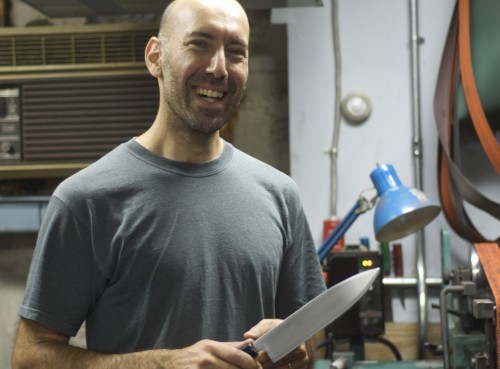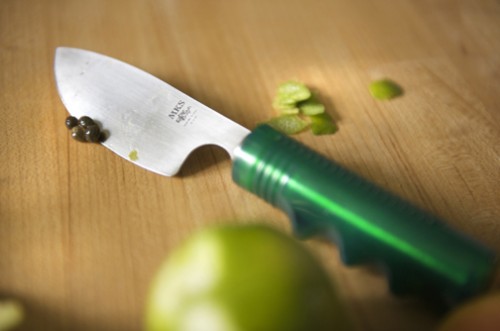Adam Simha has done a lot of interesting things in his life. He’s been a chef, a baker, a drummer, even a sound effects maker, but nothing ignited his imagination as intensely as when he first put fire to steel in a metalworking class at MassArt. Even the smell of the workshop intoxicated him. And what he could do there was more compelling still. He began by crafting sculptural items, and then designing and fabricating furniture pieces. What started as a hobby eventually evolved into a part- and then full-time gig, when he founded his own company, MKS Design.
His introduction to knifemaking happened almost by chance. Though he was already making furniture professionally–if you’ve been to Toscanini’s ice cream shop in Central Square, you’ve likely seen or sat on one of his sleekly modern chairs or sofas–he was still taking courses at MassArt, essentially to ensure access to the metal shop. The problem was that he was running out of classes to take. Then, a friend suggested he take a class with master bladesmith, J.D. Smith.
“He warned me,” Simha says of Smith. “He said, ‘This is a disease for which there is no cure, so consider carefully before you begin.’ He’s very dramatic. It’s wonderful; he has this way of bringing you into the experience of creating this tool and addressing the material, which I had been addressing a lot for years, but never in such an explicitly fine-grained way (pun-intended). You have to be so careful, and so attentive to detail, if you want to make a really sublime utensil.”
As we talk in his small Cambridge workshop, which is chock full of metalworking equipment (a stamp, anvil, press, etc.), he rifles through a drawer and pulls out the first knife he ever made in Smith’s class. He scrutinizes it carefully, and smiles as he recalls the epiphany of its creation, what he calls a “dream-come-to-life” moment, that happened at the very end of the long, sequential process, and he realized that he’d made an object that’s both beautiful and functional. “It’s a knife,” he says, turning it over in his hands. “You could survive with this thing! I don’t know whether that appeals to other people, but it certainly appealed to me.”
When he decided to start designing his own knives in addition to furniture, he added an element that has became something of a trademark of the MKS knives–their distinctive bright handles, which are made out of blue, red, green and black BMX bicycle grips. This was more than simply a flight of bicycle-inspired fancy. Sure, the handles look cool, but they also serve their function remarkably well, allowing for a comfortable, stable grip. Ultimately, while aesthetics are important, it’s the craftsmanship and ingenious design of the knives–from the angle of the blade to the quality of the steel and overall weight distribution–that is ultimately why a professional chef or home cook would choose to use one in their kitchen.
The design process itself is an exacting one, relying on trial and error, as well as testing by professional chefs, who put his prototypes through their paces. In addition, Simha designs a lot of custom blades from scratch, often to address a specific problem or task. At the time of my visit, he was in the midst of a project for John Gertsen, the bar manager at Drink. His bartenders needed a knife for chopping, shaving, and carving large blocks of ice. Designed for strength and durability, the prototype had just come back from a bout of testing at the bar. In spite of the serious pounding it had taken, the blade showed no sign of wear, with the edge still sharp enough to shave the hair off the back of Simha’s hand. More important still was the feedback from the bartenders, suggesting small changes that would allow him to refine his initial design.
One of the biggest changes in the last year has been at the fabrication stage. When he started MKS knives, Simha couldn’t find a company in the U.S. who was willing to produce knives to his specifications in such small quantities. About a year ago, however, he started working with Lamson & Goodnow, who operate out of an old, self-sustaining, water-powered factory. It’s a partnership that has Simha particularly excited. Their proximity allows him to work closely with them to ensure the quality of the materials and design. Typically, he’ll do much of the finishing work at his shop. In addition, he’s also begun to license knife designs to be produced by Lamson. These new knives (and, from the photo I saw, they look gorgeous) have just begun production.
As we talked, we looked over the various knives in his collection from hefty 10″ chefs knives that could cut straight through bone to paring knives, which are appropriate for more delicate work. It occurred to me that though the knife is one of the most oft-used and versatile tools in the kitchen, it’s also one of the most abused and misunderstood. If you’re like me, you have a hodgepodge of different knives at home, most of which were inherited or bought with little thought about their ultimate use. I asked Simha what to look for when purchasing a knife and have distilled his advice down to a few key points here.
First, he says, most cooks don’t actually need very many knives–one, two, maybe three, if you do a lot of butchering. Think about what you usually cook and tailor your purchase to that. For example, if you cook a lot of acorn squash, you’ll need something to cut through it handily. Second, evaluate how much you’re willing to invest in sharpening and maintaining your knife properly. This is more an investment of time, rather than money. Third, once you’ve decided on the type of knife that you need (a chef’s knife, paring knife, or something altogether different), go to a store and try out several different versions. If the shop allows it, cut some food with them and gauge how they feel in your hand. Buying a knife is a personal thing. There is no right or wrong answer.



